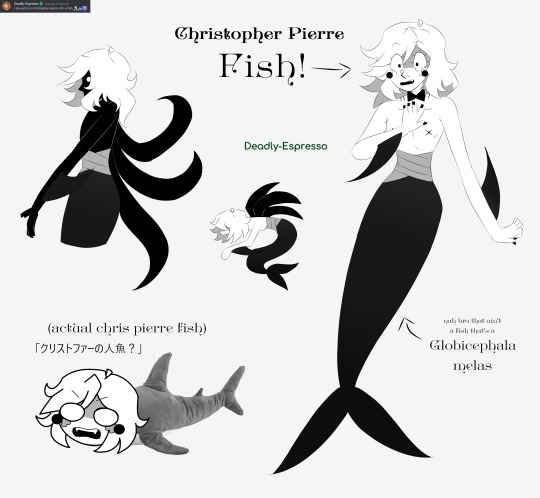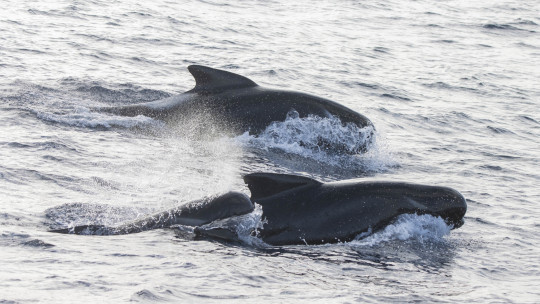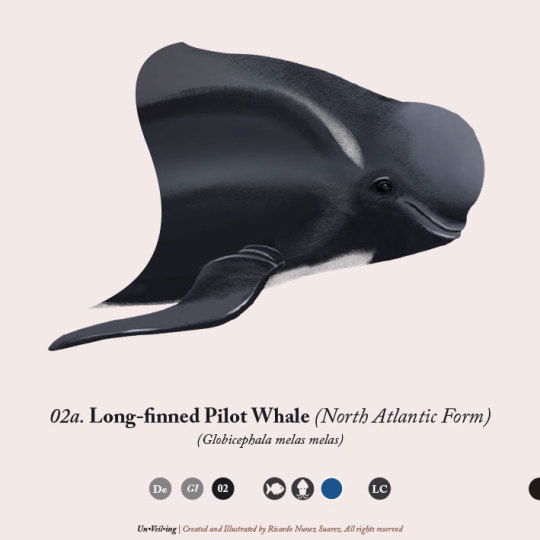#long-finned pilot whales
Explore tagged Tumblr posts
Note
Hi, This is sooo so very cool, I’m in the middle of my final exams right now and every so often I forget why I love biology, and chemistry and then I think dammit I should have just picked languages as my high level courses. But whenever I see your blog, I am reminded of why I want to study biochemistry. It’s just so insanely cool. Anyways, you don’t have to answer, but I just wanted to let you know. Many thanks!!!!
String identified: , T c, ’ t a a gt a t gt g, a ct a t t at a t c agag a g c. t g, a at t t ct. t’ t a c. Aa, ’t a t a, t t at t t . a ta!!!!
Closest match: Globicephala melas genome assembly, chromosome: 19 Common name: Long-finned pilot whale (dolphin)

#tumblr genetics#genetics#the-name-was-lost#asks#YOOO FIRST DOLPHIN!!!#dolphins#also it makes me so happy to hear that this blog gets you excited about science again#i've almost quit several times. shit sucks#but it makes me so happy to see real scientists and students find joy in this silly little blog#you gotta push through. for the aminals#for the long-finned pilot whale (which is actually a dolphin)
654 notes
·
View notes
Text

Southern long-finned pilot whale Globicephala melas edwardii
Observed by whale_nerd, CC BY-NC
#Globicephala melas edwardii#southern long-finned pilot whale#Cetacea#Delphinidae#cetacean#dolphin#whale#Pacific Ocean
60 notes
·
View notes
Text
Greetings!
You may call me Min, and my main is @bored-dromaeosaur.
This is for posting about my silly nonhuman self! You can ask me about alterhuman shit too. :::3
#kin blog#cryptidkin#eldritchkin#long finned pilot whale therian#long finned pilot whalekin#pilot whalekin#pilot whale therian#cetaceankin#cetacean therian#birdkin#wingkin#gullkin#gull therian#seagullkin#seagull therian#wolfkin#wolf therian#bird therian#arctic wolf therian#arctic wolfkin#caninekin#dinosaurkin#dinosaur therian#paleotherian#palaeotherian#nonhuman#alterhuman#therian#otherkin
29 notes
·
View notes
Text

Long-Finned Pilot Whale (South Emisphere Form) Globicephala melas edwardii) Family: Delphinidae Genus: Globicephala Status and Conservation: Least Concern This is the final subspecies in this small family, and they closely resemble each other. Distinguishing them requires expertise. This form, for instance, exhibits more prominent white stripes on its sides and top compared to the other subspecies, though the presence of this pattern is not exclusive to it. This form resides in the Southern Ocean near the Antarctic Pole, as its name suggests. __________________________ Please consider joining the club where you can find more detailed information about every post here, spreads of the book that is in the making, and have access to the collectible E-Stickers. Just click here
#long finned pilot whale#pilot whales#dolphin#whale#illustration#drawing#scientific illustration#illo#wild animals#wildlife#sea mammals#sea monsters#artist on tumblr#animals#mammals#animal
37 notes
·
View notes
Text


#polls#animal polls#cetacea tournament#indo-pacific humpback dolphin#long finned pilot whale#dolphin#whale
2 notes
·
View notes
Text
It takes an hour to drive from Tórshavn all the way up north to Hvannasund, a fishing village of 248 people. Marshfield and Østrem won’t tell me if someone tipped them off, or if there’s another way they heard about the hunt. But they do share their plan: to document everything, even if it means breaking the law by flying a drone over the site of the hunt.
The roads are drilled straight through mountains to save the trouble of climbing up or around, and each time we exit a tunnel, I catch my breath. Waterfalls flush down emerald hills, dotted with small sheds for sheep, and tumble into glittering fjords. Marshfield talks about how nervous he is. It’s his first grind; he’s unsure how he’ll handle the blood.
Østrem has more experience with it. He was here for a couple of months in 2022 after several years of volunteering with other animal rights organizations in Oslo, Norway. He’s horrified by the way people treat animals around the world, including at fish farms in Norway. To him, the grind is just one example of the way humanity abuses other beings.
Marshfield is similarly resolute. He got involved with Sea Shepherd about eight years ago, after seeing an online photo of a slaughtered whale that left him deeply upset. His activism gradually scaled up; he started by donating, then sharing things on Facebook and selling T-shirts. Eventually, he joined Sea Shepherd campaigns in Sicily and Iceland. Now, he’s here. He grows more solemn as we drive, steeling himself to see a dead whale in person.
Watson’s followers have a long history of fighting the grind. Activist groups, including Sea Shepherd, first started protesting the tradition back in the 1980s, putting the archipelago under global scrutiny. “People were telling us it didn’t look nice,” says Bjarni Mikkelsen, marine mammal specialist at the Faroe Marine Research Institute.
According to Mikkelsen, environmentalists grew troubled over whether the hunt was hurting pilot whale populations. “People walked around with banners, saying it was unsustainable,” he says. Around the same time, sighting surveys were launched to estimate population levels. The North Atlantic Marine Mammal Commission, a body comprising the Faroe Islands, Greenland, Iceland, and Norway, has since carried them out every six years.
Using standard international sampling techniques, surveyors most recently estimated the population of pilot whales in the Faroes–Iceland area to be around 380,000. Survey to survey, this number changes, depending on timing and coverage. But scientists consistently report abundances that can sustain the Faroese catch. “The population is high compared to other species in the North Atlantic,” Mikkelsen says, and there’s no significant downward trend.
Greenpeace eventually abandoned their opposition. But Sea Shepherd held firm. In 2014, under Watson’s leadership, around 70 volunteers descended on the islands for Operation GrindStop, donning black hoodies stamped with Sea Shepherd’s distinctive Jolly Roger insignia and physically intervening in hunts by jumping into the bay. The following year, the organization returned with the same conduct, resulting in fines, arrests, and court cases.
Resentment for the disturbances lingers among many of the Faroese, especially since Sea Shepherd Global continues to fight the hunt, though in softer ways. “Sea Shepherd’s history with the Faroe Islands has been quite aggressive and colorful,” says Valentina Crast, the group’s current Stop the Grind campaign coordinator. Now, she’s working on a tamer strategy, focused on building a local community of supporters.
Watson’s new foundation, meanwhile, wants to maintain the same level of pressure Sea Shepherd once brought. “We’re living in a world where there is no enforcement of international conservation laws,” Watson says. “The high seas are the Wild West. And we’re sort of vigilantes.”
The 73-year-old self-proclaimed pirate (a title confirmed by a United States Court of Appeals in 2013) is against the killing of whales on moral grounds, no matter who does it, or how. He has carried out his brand of vigilantism for nearly 50 years. Talking to him is like talking to a buccaneer who shares stories of sirens and sword fights, except Watson’s tales consist of ramming Portuguese whaling vessels, sinking Icelandic ships, and tricking Soviet soldiers. He’s been criticized for targeting Indigenous peoples over their traditional subsistence hunting practices, including seal hunters in Canada and teenage whalers in Alaska.
After the crackdown by the Faroese government, protests quelled for a while. But in recent years, social media and an increase in tourism have put the grind back in the spotlight. The Faroe Islands now receive about 100,000 visitors a year, and the nation is often included on top destination lists for its dramatic landscapes. During the summer when seabirds breed, bird lovers flock to spot puffins, guillemots, and other species that nest by the thousands on the steep cliffs. Hilton opened a hotel here in 2020, and the local airline is testing out a weekly direct route from New York. Unaware tourists might encounter a whale hunt occurring in the harbor, as those on a docked cruise ship did last summer; in that instance, most were not happy about the spectacle. Such stories, along with rather gruesome photos of the hunt itself, can be shared worldwide. The Captain Paul Watson Foundation seeks to capitalize on this.
Seizing its moment after splitting from Sea Shepherd, the Captain Paul Watson Foundation sent its first vessel—the John Paul DeJoria, registered in Jamaica and named after the cofounder of John Paul Mitchell Systems hair products—to the Faroe Islands in July 2023 to stop the whale hunts. But the Faroese government barred the ship’s entry to the archipelago via executive order. Ultimately, Watson made only two brief, albeit dramatic appearances, entering the nation’s waters once in an unsuccessful attempt to reach a grind and again 10 days later at news that someone had spotted a pod.
After the second breach, Jamaica stripped the ship’s registration at the request of the Faroese government, and the John Paul DeJoria was ported in the United Kingdom. Land crew, including Marshfield and Østrem, remained in Tórshavn to document what they could.
#current events#environmentalism#ecology#animals#marine life#hunting#whaling#food and drink#operation grindstop#denmark#faroe islands#iceland#streymoy#viðoy#tórshavn#hvannasund#bjarni mikkelsen#john paul watson#valentina crast#sea shepherd#faroe marine research institute#north atlantic marine mammal commission#captain paul watson foundation#dolphins#pilot whale#long-finned pilot whale
2 notes
·
View notes
Text
"I wanted to write a poem about how the extreme heat of the ocean is breaking my heart, but the whales beat me to it. In late July, almost 100 long-finned pilot whales left the deep, usually cold waters where they live—so deep, so cold that scientists have barely been able to study them. Together they came to the coast of western Australia and huddled into a massive heart shape (if your heart were shaped like 100 black whales, like mine is). Then, collectively, they stranded themselves on the shore. As soon as they lost the support of the water, their chest walls crushed their internal organs. They literally broke their hearts. Choreographed under helicopter cameras.
I want to write a poem about how capitalism is a sinking ship and how the extreme wealth-hoarding and extractive polluting systems that benefit a few billionaires are destroying our planet and killing us all. But the orcas beat me to it. Off the Iberian coast of Europe, the orcas collaborated and taught each other how to sink the yachts of the superrich. They literally sank the boats. While Twitter cheered.
The sinking ship is no longer a metaphor. The broken heart is no longer a metaphor. Who needs a metaphor in times as hot and blunt as ours? Let’s make it plain."
-- Alexis Pauline Gumbs
2K notes
·
View notes
Text


I left out sperm whale and blue whale bc they definitely would not like it
89 notes
·
View notes
Text

Meet the long-finned pilot whale (Globicephala melas)! Reaching lengths of up to 25 feet (7.6 meters), it's the second largest member of the dolphin family; the orca is the largest. This nomadic cetacean is widely distributed, and can be seen throughout the oceans of the Southern Hemisphere. It wanders in search of food such as squid, fish, mollusks, and other sea critters. This species is highly social, with family units called pods consisting of up to 100 members. Pilot whales have even been observed participating in multi-pod gatherings with more than 1,000 individuals congregating at once!
Photo: titouan_roguet, CC BY-NC 4.0, iNaturalist
#science#nature#natural history#animals#mammal#whales#pilot whale#did you know#fact of the day#ocean life#dolphin#cetacean
387 notes
·
View notes
Text


(The Distortionist)
I unfortunately had to turn The Distortionist into a fish because it's MerMay (oh no)
(also for a little bit of story about this image, while deciding on what kind of sea creature to turn Christopher into, I originally thought of turning him in a shark (that's where the idea of the bottom left image came from), but nah I didn't fit for some reason. I had also considered turning him into a cephalopod (like a cuttlefish or an octopus) but nahh that felt too stereotypical even if cephalopods tend to be crafty and deceptive characters (although I did end up letting him keep the extra arms on his back). I end up settling on basing his lower half on a cetacean, specifically a long-finned pilot whale (Globicephala melas) since cetaceans are also known for being very smart sea creatures and also the smooth, dark flesh of pilot whales just fit with the Distortionist for whatever reason.)
Oh also as a bonus I ended up drawing the Distortionist's head over a photo of an IKEA shark because I wanted to at least actually make the Distortionist into a FISH (the chris pierre fish design I settled on ended up just giving him the lower half of a pilot whale)
45 notes
·
View notes
Text
6 notes
·
View notes
Text

Southern long-finned pilot whale Globicephala melas edwardii
Observed by oscarkokako, CC BY-NC-ND
#Globicephala melas edwardii#southern long-finned pilot whale#Cetacea#Delphinidae#cetacean#dolphin#whale#Oceania#New Zealand#Pacific Ocean
24 notes
·
View notes
Note
I think if you were a cetacean, you would be a long-finned pilot whale.

you know i do feel identified
8 notes
·
View notes
Text

Long-finned Pilot Whale Globicephala melas melas Family: Delphinidae Genus: Globicephala Conservation Status: Least Concern This whale is not a whale but a large dolphin. Despite the minimal differences between the Short-finned Pilot Whale and this species, they are indeed two distinct species. If that is not perplexing enough, this dolphin also possesses one subspecies—actually two, although one became extinct long ago along the coasts of Japan. In fact, scientists aren't sure that was a subspecies but almost sure. Let's say %93,2 sure. You see, science is consistently regarded as an exact discipline. Consider joining the club here. No money? No problem. Follows, likes and shares will help too. Hasta la vista.
#Long finned Pilot Whale#pilot whales#whales#dolphins#illustration#drawing#scientific illustration#illo#wild animals#wildlife#animals#artist on tumblr#mammals#whale#conservation#endangered species#extinction
34 notes
·
View notes
Text


0 notes
Text
More than 100 long-finned pilot whales stranded along the shores of Western Australia on Thursday have returned to the ocean, while 29 died on the beach, wildlife officials said.
Officials were working to remove the 29 whales that had died on the beach, Pia Courtis, a regional wildlife officer with the Parks and Wildlife Service for Western Australia, said on Thursday in a news conference posted by the agency on social media. The agency planned to take biological samples and measurements from the dead whales for research.
After marine officials and volunteers had helped the other whales back out to sea, boats were on the water and a spotter plane was monitoring the area to ensure they did not return to shore.
The four pods of 160 pilot whales were spread across about 1,640 feet of beach at the Toby Inlet, near the town of Dunsborough, in Western Australia on Thursday morning, local wildlife officials said, in a statement on social media.
Photos shared by the wildlife service on Facebook showed rows of whales lying on the shore as crowds gathered to see the mass stranding.
The rescued whales had moved farther offshore on Thursday and were last seen traveling north, the wildlife department said.
“So far, so good — they haven’t made it back to shore, but we will keep monitoring them,” Ms. Courtis said.
Officials said they did not know what had caused the stranding, which included mostly adult females and a few calves. In general, experts have theorized that the causes for such strandings may include pods of whales following a sick, or stuck, whale and getting stuck themselves; the confusion brought about by undersea noise caused by humans; or an attempt to avoid predators.
Several mass strandings have unfolded in Australia in recent years.
7 notes
·
View notes